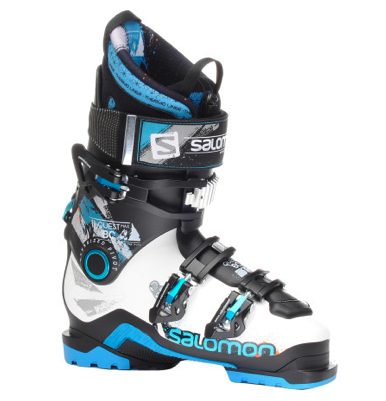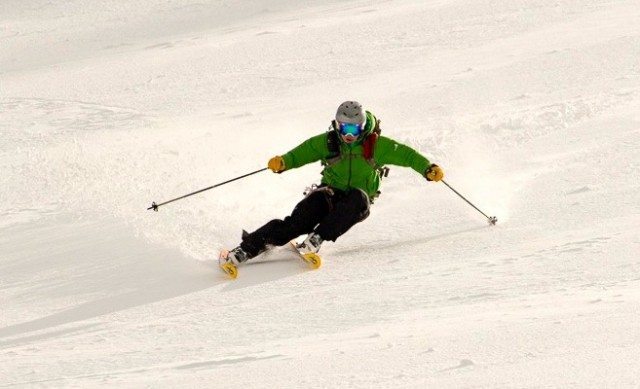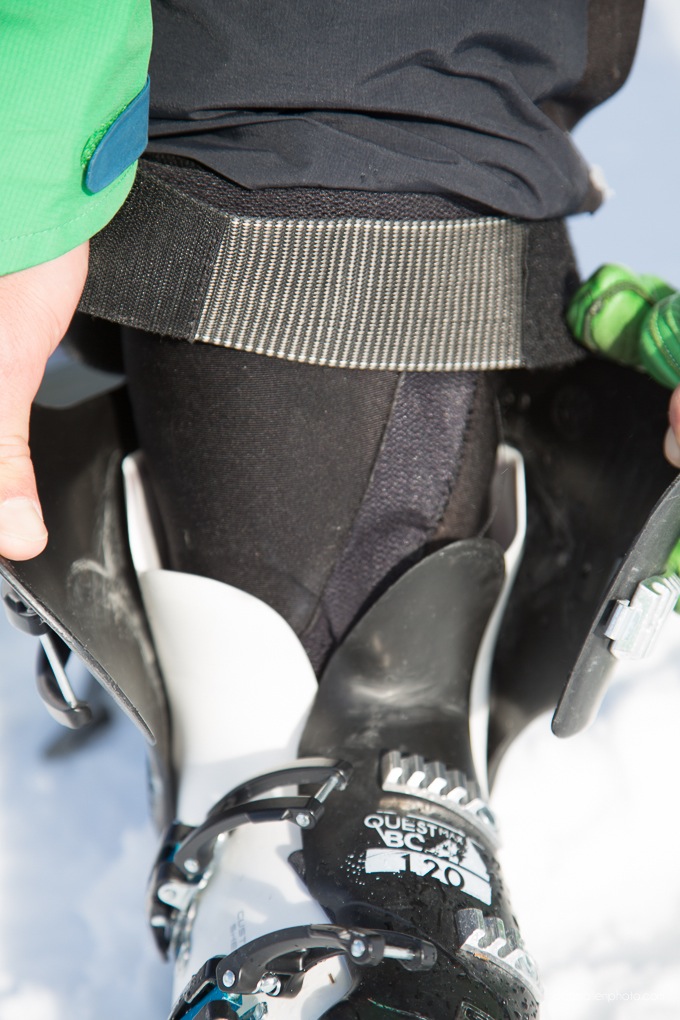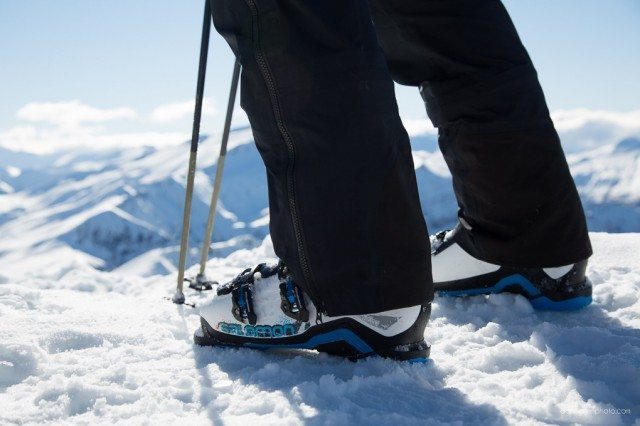
Salomon Quest Max BC 120
Size tested: 27.5 / Boot Sole Length: 315mm
Weight: (with DIN soles and stock liners)
- Right: 1990 grams
- Left: 1984 grams
Test Locations: New Zealand Canterbury club fields, Treble Cone, Mt. Hutt Heli Skiing
Days tested: 14
First Impressions
I spend most of my season ski touring in Alaska, and have used a lot of different alpine touring boots over the past few years. I also travel a good bit to ski, and when I do, I like to take just one pair of boots that I can use inbounds, but also for big touring days.
For our review trip to New Zealand I decided to test the new Salomon Quest Max BC 120.
Salomon has had boots featuring a walk mode for several years, but the Quest Max BC 120 seems to be the first boot with added emphasis on uphill performance.
In comparison to other boots in the “Walk and Ride” line, the Quest Max BC 120 has a pebax lower shell and a thermomoldable liner to save weight. And new this season, Salomon will also offer Walk to Ride (WTR) sole blocks with tech fittings.
I now have two weeks in the Quest Max BC 120, and I’ll start with initial observations and comment based on experience when pertinent.

Walk Mode
Except for the Dynafit Vulcan and the Dynafit TLT5, I have not worn or tinkered with any AT boot that didn’t have at least some play in the walk mode in the “downhill” position—until the BC120.
When this boot is locked, there is zero discernible play when hand flexing or when flexing with the boot on my foot. The most comparable boots I’ve used recently include the Tecnica Cochise Pro 130 and the Dynafit Titan, and both had play in the cuff that was noticeable while skiing from day one. It will be interesting to see if the Salomon walk mode will remain tight after heavy use.
Range of motion is much less than the Vulcan or Scarpa Maestrale, and comparable to a Tecnica Cochise Pro 130. My initial impression is that the cuff will move about 10 degrees rearward of vertical. My suspicion is that it will be fine for my style of skinning, which does not typically involve long strides.
The oversize shell pivot seems like a good addition. I wore down the cuff articulation on my first pair of Dynafit TLT5’s to the point where the carbon was wallowed out and a lot of play developed, presumably from so much touring. Since then I’ve paid more attention to cuff rivets. The larger diameter pivot on the BC 120 is intended to increase lateral stiffness, but also to create more surface area to evenly distribute wear. Seems like a good idea to me.
So far I have not used the boots skinning, but I have taken quite a few hikes and ridge walks in them. The walk mode is effective and comfortable. It doesn’t provide enough range of motion for unimpeded downhill strides, but overall, it’s adequate.
Liner
The BC 120 has one of the most impressive liners I’ve ever seen on a touring boot. It felt thick enough to keep my foot warm, but it’s not so soft that it will get sloppy right away. On the one day that I skied with the stock liners, I found that the speed lacing system worked well without any slipping or loosening. My favorite feature is the true, alpine-like tongue that’s well padded, stiff, and comfortable.
Unfortunately, my relatively high instep caused a lot of pain that I couldn’t remedy with heat molding or insoles. I ended up swapping out the stock liners for a pair of Inuition Powerwrap Plug liners that were molded for me by the folks at Gnomes Alpine Sports in Darfield, NZ. I’ve had a snug and comfortable fit ever since.
Shell
At first glance this boot appears to have traditional alpine overlap construction. On closer inspection, however, the lower shell does not actually overlap across the foot, but rather relies on the black plastic tongue interfacing with the lower and upper shell.

Buckles
The buckles function well—the single buckle on the cuff is adequate, and is a proven design on boots such as Salomon’s popular Ghost series. The powerstrap is functional but I miss the camming powerstrap system used on the Tecnica Cochise line and on the new K2 Pinnacle series—I’ve found that this system is significantly more powerful and much easier to unlatch for walking / skinning.

Sole Blocks
The attachment points feel very solid and are similar to those offered on the Cochise, albeit a bit easier to slide on and off. The tech compatible soles are also compatible with all of Salomon’s WTR bindings, which include the new STH2.
After four days of skiing, I noticed that the screws in the soles needed a little bit of tightening. I’ll keep a close eye on it but suspect it was more due to my severe jetlag when doing the sole swap rather than any issue with the boot. I have been on the boots another 10 days at least since tightening them and have not noticed any issues.
NEXT PAGE: FIT, SKIING PERFORMANCE

Great review!
Will you guys be reviewing the Lupo SP anytime soon? Would love your insight.
Thanks!
We’ll see, Chris. It’s on our radar, but so are a number of other boots we’re planning to review early season. Our facebook page will be a good place to see what stuff we’ll be reviewing early season.
Is it comparable in lateral flex to the lange 130 rx?
Or the bd factor 130?
Hi Rod, I’ve not skied either of those boots. I am particularly interested in how the BC 120 compares to the Factor MX and am hoping to try a pair this winter.
Personally, I’m more interested in whether a boot skis well for my skis, foot specifics, ability and conditions than how the flex compares to other boots but will try to provide the best comparisons I can.
Trying to figure out my one-boot, one-ski quiver for this coming season. Demands aggressive resort skiing and up to 7-day skinning trips. Do you think this boot will cut the mustard? How about compared to something like the Scarpa Freedom SL (also a peebex shell)? [Generally accepted principle that fit is the most important attributed applies, obviously.]
As for skis, lusting after the 184 Exit Worlds with a SI&I setup. So, same question for these. In your mind, is this an ideal setup, or are there notable shortcomings? What would you go with for a boot, bindings, ski setup that charges and tours?
Hi Aaron, Thanks for you comments. If you have to do all of that on one boot I think this is a great choice. Personally, I prefer to ski alpine bindings with DIN certified soles which limits your choices of touring boots, and counts out the Tracker. One way to get around that might be the WTR system. If you opt to use a binding like the STH2 on your SI&I system you would be able to use the BC120 all the time with the touring soles and I think could work well.
The BC 120 is the boot I’ve used so far that has the option to use tech bindings but will still work safely in any alpine binding and it would be at the top of my list. Personally, I prefer to use a dedicated touring boot like the Vulcan for touring because of it’s lighter weight and short rockered sole. If I was going to be traveling and could only bring one boot for touring on tech bindings and skiing on alpine bindings the BC 120 is the best I’ve come across. Once I added the Powerwrap the flex was sufficient for me. (and I saved a bit of weight).
For a 7 day tour this boot will be fine as long as you have a good fit and you won’t be chasing friends on superlight rando gear. I’ve never used the SI&I but it does seem like a good choice for what you’re looking to do. I love tech bindings and rarely see the need for a burlier rig while touring but if you want one set-up for everything, all season, your idea sounds pretty sweet.
The only other thing I’d say is, depending on your body size and boot flex preferences you could take a look at the Quest Max 130 which is supposed to be a bit stiffer but also heavier as it swaps out the lighter pebax for a heavier PU lower shell. I have not skied it yet.
See my review of the Exit World for details on that. I have not skied the Freedom yet but would love to try it. To me, the primary boots in this category of reasonably light and have swappable soles are the BC120, Factor MX 130, Freedom, and the Cochise line. I think the Salomon is the only one that would work, unmodified, in an alpine binding with the tech soles installed. As you said, fit should be your most important determinant.
Hi Paul
no cuff play in ski mode also in case of Atomic Tracker 130… Although it’s a different functionality (climb, not tour) the Tracker does it all well.
Since Amer owns both Salomon and Atomic, I wouldn’t wonder to find in Q-Max BC a kind of an upgrade system of ski-walk used by the Tracker… Did you get the chance to compare on them?
Hi Mario, I’ve not skied the Trackers but have flexed them in the shop and I agree with you that the walk mode feels solid. I do not know the details of how the internal mechanism differs but it’s a good question. Personally, I’m only interested in a boot with a walk mode if it has the capacity to be skied with tech bindings. I saw the new Atomic Waymaker boots at Gnomes Ski Shop in New Zealand this summer and they look to have a solid walk mode that is also similar, from the outside, to the BC120.
Paul, is the only difference between these and the Salomon quest max 130 the flex and weight?
Hi Ian, I believe that to be the case. I played with a pair last year but have not skied them. The website also indicates that the 130 has the Custom Shell 360 feature.
Nice review! Going to see PJ @ Monods in Bann next week to get a pair of these bad boys fitted. Should pair well with my Rocker2 115’s & Guardians. Perfect side country setup! Stoked!!! Bonzo
Right on! Sounds great.
Great review. Seriously considering getting these boots. A couple q’s:
-How do they compare to the Lange XT130?
-I have a very narrow foot and like a tight fit. Could I get away with downsizing and punching the toes on these boots?
-Or am I better off getting a tight fitting pair of XMAX120s plus a sloppy pair of Dynafits for touring?
XT 130 has a smaller last meaning a more narrow fit.
Hey Dave,
1) I haven’t used the XT130. I’d be speculating if I tried to compare them. I have had the RX 130 on my foot and would say that the Salomon fit is a bit higher volume throughout with a less contoured heel pocket but that’s based on minimal experience.
2) You might be able to punch a smaller size and have great luck with it. My personal experience in doing that with other boots (Titan and Cochise) is that they ski well but are too tight for all day touring. I also had problems with the walk modes hitting my achilles when striding in downsized touring boots. Check that out in the store if you can before you commit.
3) In my opinion this is THE question regarding boots. If you tour a lot but also ski lifts frequently, you can try the single boot approach with a boot like the Quest Max BC 120 and compromise a little on both aspects of skiing. The benefits are that you’ll always be in a boot that you’re used to, it’s cheaper, and it makes traveling easier and less bulky.
Personally, I prefer to have dedicated touring boot and a dedicated boot for mechanized skiing. I get a lighter boot for touring with shorter, rockered sole and a liner and fit that works well for me for long days and climbs. I guess it depends on where you are and what you ski, but many of the best skiers I know have found that, with a good fit, they’re able to ski hard in big terrain on surprisingly light boots while touring.
Then, when I’m skiing lifts/sleds/heli/cat I pull out performance alpine boots with a tighter fit and get the best performing boot possible when I want to go hard in DIN bindings, especially if charging through tracked out snow at the ski hill.
Best of luck with the boot quandry!
When we think of the BC 120 a few things come to mind. Super light, comfortable, and downhill performance. The BC 120 is a great boot for the customer that you described. One that wants one boot for on and off piste exploring with max performance. With the addition of the WTR tech soles these boots are hard to beat. The only con that we have noticed with this boot and many other Salomon AT boots is the flex not being quite as stiff as it says it should be. With that being said, the Twin PowerFrame tech in the BC 120 makes it a bit more stiff than say the traditional Quest 120, but we feel it deserves to be addressed none the less. Overall, it is a great boot that will decrease energy exertion on the way up without compromising downhill performance. We recommend them!
was the owner of a quest MAX 130 2014.
only one day of ski on very heavy powder with salomon rocker (one)
with sth16.
ideal combo to see the gust of a beast: do the job very well but a little step a rs130 (lange), perhaps a challenger to cochise 130 pro, but heavy (4.9kg for 28).
compared on carpet to the BC 120, the 130 is stiffer, really.
perhaps on snow pebax became stiffer…
bc 120 and 130 are the same, one in pebax, the other in PU.
liner is a little different too, softer.
no other différence.
Hi
Great review. Your wrote: “So far, I’ve found that this is the first boot I can envision serving as a one-boot quiver for my purposes. It has enough support and a stiff enough flex to ski either inbounds or in the backcountry with a heavy pack, but it’s also light and comfortable and has an ample walk mode to be an acceptable backcountry boot.”
You also skied the dynafit Vulcan. what was the problem there that it is not a one-boot quiver?
Max
The vulcan is not DIN sole compatible. Thus far, I much prefer skiing 916’s or Pivots if I’m not earning my turns under my own power. This could change as bindings like the Beast become more prevalent. Moreover the Vulcan does not have the progressive and more supportive flex that I enjoy in true alpine boots. That said, if I wanted to have just one pair of boots and spent more time touring than mechanized skiing, I’d probably choose the Vulcan.
Excellent, thanks! After skiing on beast binding for a season I actually came to the point where I prefer them over alpine bindings. I trust them 100%. So for me it comes down to the progressive flex which I felt was non-existent when I tried them in the shop. But It’s hard to make any conclusions by just trying them in the shop.
Hi Paul
I am in a new pair of Salomon Quest Max BC 120s and the fit feels pretty snug and good (after heat moulding) as does the flex, but I have a big problem with shin bite. When I flex the boot forward, my shins (particularly my left one) hurts to the point that on hard bumpy terrain, my shins are so sore that I struggle to ski at all. At the end of the skiing day, the lower part of my shins are red and sore.
I did not have this problem with my previous boots, the Lange RS 120 so I don’t think stiffness is an issue. My shell size is largely unchanged (285mm on the Salomons vs 286mm on the Lange).
At the suggestion of the boot fitter, I have tried the Eliminator tongue in my boots and it improved things somewhat in my right boot but did not help very much with my left. It almost feels like there is a hinge point in the tongue such that when I flex the boot beyond a certain point, it starts hurting which eases off as soon as I take the pressure off it.
I am wondering if I should swap in my old Lange liners instead as I find the Quest Max BC 120 liner tongue to be pretty stiff. It’s would be a shame because as you say, the liner looks like a really high quality liner.
Any thoughts would be much appreciated.
thank you
Ian
Update on my experience with this boot. Could not fix the shin bang issues with the stock liners so decided to try a pair of Intuition Luxury liners and lo and behold, shin bang disappeared. The intuition liners also gave an even snugger fit which is an added bonus. I had no issues with only 3 buckles but decided to add a booster strap as the Intuition liner is slightly taller than the stock liner. Works a treat and now I can’t imagine not skiing without a booster strap.
With these modifications, the boot feels great.
A few comments about my 15 days on the Quest Max BC 130, 28.5:
-Me: 6’5″, 215 pounds; fairly aggressive skier for a 46-year-old, but not a hucker; street shoe size: US 14; prominent 6th toe; a bit knock-kneed
-Heat molding: Worked like a dream. Was able to size way down. Snuggest fit I’ve ever had.
-Dropping down in size gave me incredibly consistent pressure from instep to shin-top. Never experienced that before. I am in love with this feeling.
-Flex: Been using this with a 196 Bodacious and a 192 Atlas. They’re stiff enough to drive the skis, but there’s a definite limit. The few times when I’ve been caught off guard and hit a mogul trough too hard, the boot got completely overwhelmed, warped off to the side, and I thought I was going to break my ankle. As long as I’m aware of this limitation, though, they’re wonderful. I might try a Booster Strap to see if I can get a little more stiffness out of them.
Update after four more days on these: Overpowering the boot seems to have been a fluke (probably me being somewhat less than graceful). These things are great.
Great info from your personal experience. I’m on the fence about these vs the X-Pro 120 and honestly what it’s now boiled down to is cuff buckles. Silly, I know but from someone whose never skied a boot with less than 4, it’s causing hesitation. Appreciate your comments and experience.
Hi Jeff. Just saw this. Having one buckle up-top hasn’t been a problem at all. Feels snug, and the cuff is supportive and responsive.
I’ve put 65 days on these now — Overpowering these boots can be a bit of a problem. When I hit an unexpected bump when going too fast or skiing with limited visibility, they transfer too much force to my talus bone — really painful, and I’m worried I’m going to break my ankles in these. I’m not sure if this is a common complaint for too-soft boots, or if it’s a problem that’s specific to this design. Considering using ZipFits to boost the stiffness.